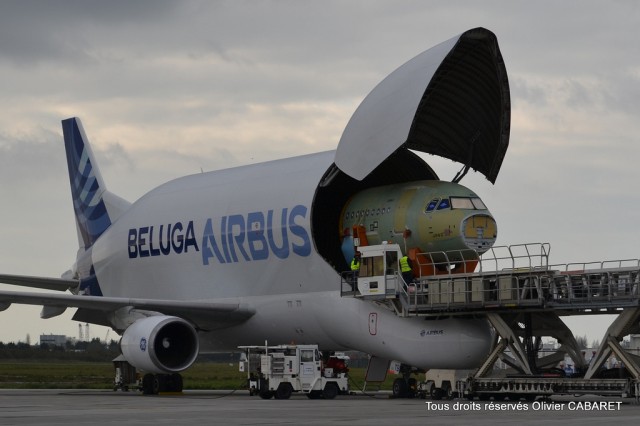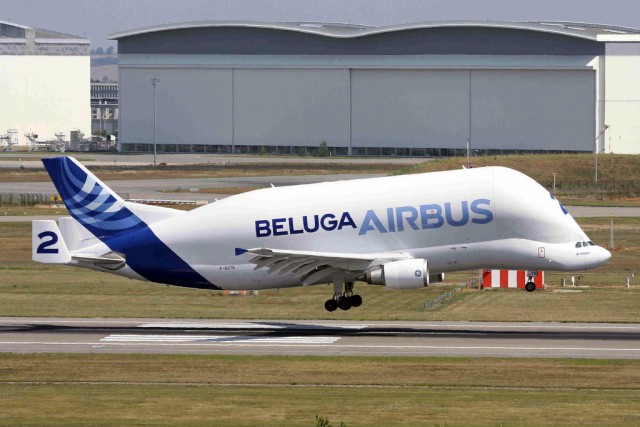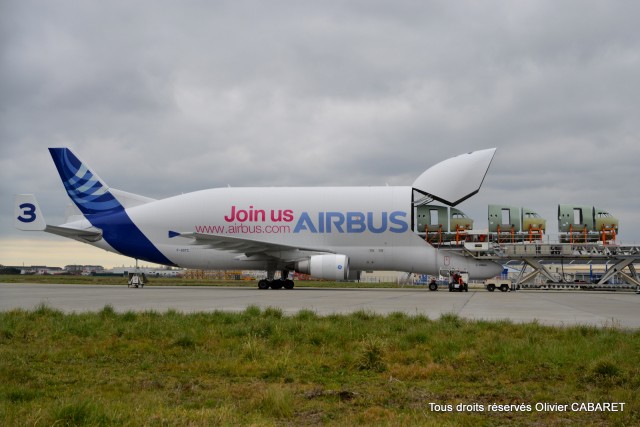
Out comes the nose section of an A320 aircraft from an Airbus A300-600 Beluga “Supertransporter” – Photo: Olivier CABARET | Flickr CC
This is an excerpt from Paul Thompson’s story on NYCAviation.com…
Throughout Airbus’ first two decades in business, its competitors at Boeing would joke that ’œEvery Airbus is delivered on the wings of a Boeing.’ That statement was both accurate and fair, being that Airbus had to use modified Boeing Stratocruisers known as Super Guppies. Yes, Airbus was transporting parts for its own jets inside 1940s-era planes built by its only real competitor.
As time progressed, Airbus finally resolved the issue by designing its own transport based on one of their own planes ’“ the A300 twin-engine jet.

A Beluga in the air looks almost like a Beluga whale out of water – Photo: Ken Fielding
The resulting A300-600ST (ST for Super Transporter) became commonly known as ’œThe Beluga’ for its bubble-like forehead resembling the Beluga whale. To accomplish the plane that seems to defy every law of aerodynamics, Airbus employed some major structural changes.
BONUS: Super Guppy Delivers Space Shuttle Trainer to the Museum of Flight
Starting at the nose, Airbus lowered the cockpit below the cargo deck so that the cargo area could be loaded without having to disconnect any of the vital electric and hydraulic lines running to the rest of the plane. The design kept the A300’s lower fuselage, wings and landing gears, but added a cavernous cargo area on top.

A320 noses are unloaded from the Beluga – Photo: Olivier CABARET | Flickr CC
At 49,440 cubic feet, the Beluga’s cargo volume ranks second between Boeing’s 747-LCF Dreamlifter (65,000 cubic feet) and the Antonov An-225 (45,909 cubic feet). The Beluga is hampered by its weight lifting capability, which is only 47 tons (103,617 pounds) or roughly the weight of an empty 737. Its cargo bay measures 25 feet in diameter. The Beluga has a maximum takeoff weight of just over 341,000 pounds, while the Dreamlifter tops out at 803,000 pounds.
BONUS: Antonov AN-225 Photo Tour
In comparison, the 747-8 freighter is capable of lifting over one million pounds, and the An-225 can lift over 1.4 million pounds. The Beluga is also incapable of hauling sections of the A380 due to its size. Those parts are still taken by barge or road convoy to the A380’s final assembly location in Toulouse.
Continue reading On the Wings of Giants: Airbus Banks on the Beluga on NYCAviation.com